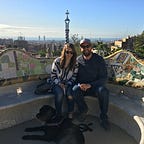McClarKinnon Adventures — Out on the Spree
Justin has dreams of kayaking through the fjords of Scandinavia, in the wildlife preserves of Germany, and along the Adriatic Coast of Croatia. But before we make plans or jet off to the waterways, we figured it would be a good idea to practice our rowing skills.
Kayaking seems like a great way for us to explore, and to see new places from new perspectives. And with COVID-19 causing us to be more cautious, time on a boat is a way to ensure our safety away from crowds.
So as we make plans for traveling this fall (if COVID numbers remain stable) and with a large anti-vax/anti-Corona measure/far-right protest taking place in Berlin, the sunny and not-too-hot Saturday seemed like the perfect day to test our kayaking skills.
We rented kayaks in East Berlin, on the Rummelsburger See. The first test of our kayaking skills was to get Tessa in the boat. Tessa doesn’t like the water; she prefers to jump over puddles and never comes into lakes, oceans, or rivers despite our efforts (and bribes).
These photos from Hamburg (more on that trip to come) captures Justin and Tessa’s feelings about water.
Because she avoids water so much, we’re not sure she could even swim. That’s why we waited to begin kayaking with Tessa until she had her own life vest. But even all geared up, we still had to lift Tessa and put her into the front of Justin’s kayak.
Justin was in a two-person kayak with Tessa as a co-pilot. I was in a single kayak. After our time kayaking in Thailand, and learning from our friends Scott and Brian, that a double kayak was sometimes called the “divorce maker”, going in our own separate boats seemed like a good idea. Both of us in our respective kayaks, we were off.
We paddled past the houseboats in Rummelsburger See, we glided past the two nature reserve islands and out to the Spree itself. The river was wide enough to host kayaks, canoes, tour boats, and motorboats. It was relatively easy sailing; Tessa seemed to enjoy herself and spent most of the ride with her head up sniffing the air and looking at people and birds that we passed. She didn’t like the waves from the other boats, but the river was pretty calm. Paddling did use some muscles that don’t otherwise get a lot of work!
We passed by beautiful green parks and saw people picnicking along the river. There is even a swimming pool set up on a barge just off the Spree. But there were a few bigger sites that this tour gave us.
The Molecular Men are statues created by American Jonathan Borofsky. They were erected in the Spree River near the Oberbaum Bridge in 1999. There are similar statues around the world, representing “the molecules of all human beings coming together to create our existence.”
The other site is the Oberbaum Bridge, which was also our turning around point as only motorboats were allowed past. The location of Oberbaum Bridge once marked the boundary of the city and the rural areas as a wall in the 1700s, a drawbridge was built into the wall as part of the protection. In 1879, the wooden bridge was updated and became the longest bridge in Berlin. But with plans to build the Berlin subway system, it was further modified to handle road vehicles, pedestrians, and the rail line (which opened in 1902). In April 1945, the middle section of the bridge was blown up to try to stop the Soviet army from crossing. And after the war, with the Berlin Wall, Oberbaum and the Spree marked the border between the US and the Soviet sections. The bridge was all but nearly destroyed during the time of city-division but rebuilt after the removal of the wall to its former appearance.
Overall, the trip down the spree was a lovely experiment, a great arm workout, and a pretty peaceful way to spend a few hours on Saturday. We’ll keep bulking up our arm muscles and look forward to sharing other updates as we kayak on more travels.
